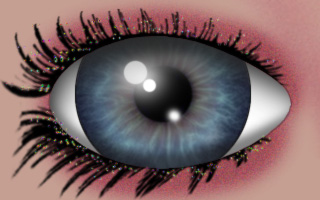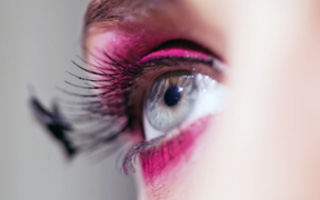Blepharitis
| |
|
Blepharitis is an inflammation of the
eyelid, along the eyelash line. The condition is not fully
understood by doctors, but there are several causes associated
with blepharitis as well as a range of treatments.
Viruses, bacteria, mites and problems in the oil glands of the
eye are all linked to blepharitis. Certain kinds of medication
such as those used for severe cases of acne can also cause
blepharitis.
Blepharitis is not conjunctivitis, or “pink
eye”, although the two may occur at the same time and display
similar symptoms. |
 |
Causes
There are two basic types of blepharitis:
• Anterior blepharitis: There are many kinds of anterior blepharitis.
Anterior blepharitis is the name of an inflammation that affects the
outside part of the eyelid around the base of the eyelashes. Bacteria,
mites and viruses can all cause anterior blepharitis.
• Posterior blepharitis:
There are also a few different kinds of posterior blepharitis. Posterior blepharitis refers to blepharitis of the eyelid
at the point where it comes into contact with the eyeball.
•
Anterior Blepharitis
Three kinds of anterior blepharitis are
staphylococcal blepharitis, demodex blepharitis and seborrheic
blepharitis.
• Staphylococcal blepharitis:
This inflammation is
caused by the bacteria Staphylococcal growing along the eyelash line.
• Demodex blepharitis:
Mites and their waste can clog the roots
of the hair follicles of the eyelashes. Everyone has tiny mites that
live in their eyelashes, but only some people experience an infection.
Researchers speculate that an unusual immune response or allergies might
cause some people to be affected by demodex blepharitis and not others.
A different kind of demodex mite can cause posterior blepharitis when
the mites enter the oil glands of the eye.
• Seborrheic
blepharitis:
This type of blepharitis is caused by seborrheic
dermatitis, which is a skin condition characterized by flaking and
scaling of the skin.
Posterior Blepharitis
A couple types of
posterior blepharitis are:
• Meibomian blepharitis:
The oil glands in
the eye are called the meibomian glands. These glands sit behind the
eyelashes and are responsible for giving the skin around the eyes a
healthy amount of lubrication. When these glands don’t function
properly, meibomian blepharitis can occur.
• Rosacea blepharitis:Rosacea is associated with dysfunction of the meibomian glands as well,
resulting in inflammation of the eyelid.
Onset
and Treatment
Each kind of blepharitis has its own
set of symptoms and treatment.
Staphylococcal
blepharitis:
Symptoms are the sensation of a
foreign body in the eye, matted eyelashes and loose eyelashes.
In staphylococcal blepharitis, a ring can be seen around the
shaft of the eyelash.
Treatments include a short course
of steroids, a four to six week antibiotics course and fluidic
acid. If staphylococcal blepharitis is left untreated, serious
complications may occur.
Demodex blepharitis
(anterior):
Symptoms are the sensation of a foreign
body in the eye, dandruff flakes at the base of the eyelashes,
itching eyelids and eyebrows. |
 |
| |
Treatments include an anti-parasitic ointment, a tea tree scrub applied
at the base of the eyelashes and a tea tree oil massage along the lash
line. Rosacea is a risk factor for demodex blepharitis.
Seborrheic blepharitis:
Symptoms are itching, burning and
flaking along the eyelash line. Treatment depends on the type of
seborrheic dermatitis that is causing the blepharitis.
Washing
the eyelash line, using warm compresses and antibiotic eye drops are
common treatments.
Meibomian blepharitis:
Symptoms are itching, stickiness and crustiness of the eyelids in the
morning,
as well as burning and a sensation of a foreign body in the eye.
Treatments include eye hygiene, eye drops, heat, medicine to increase
oil productions in the meibomian glands and increased consumption of
Omega-3 fatty acids.
Rosacea blepharitis:
Symptoms are itching, burning, redness, scaling or crusting of the
eyelid and irritation.
Treatments include eye hygiene, eye drops,
artificial tears, heat and increased hydration by drinking more water
daily.
Diagnosis
A diagnosis of
blepharitis can be made during a complete eye exam. Observation of the
condition of the eyelid and eyelash line should be enough to make a
diagnosis.
Patients who wear contacts may have to temporarily
discontinue their use of the lenses until the inflammation goes away. If
a patient used any eye makeup products while they were experiencing
blepharitis, the products should be thrown away in case they were
contaminated.
Warm compresses can help with the symptoms of
blepharitis. Soaking a washcloth in warm water and leaving it across the
eyelids for five minutes can loosen any crustiness that builds up at the
base of the eyelashes and loosen any debris clogging the oil glands. You
can gently massage the eyelids as well. Always be very careful when
touching your eyes and be sure not to put too much pressure on your
eyeball.
Using a Q-tip to clean the eyelash line with a diluted
baby shampoo or another mild soap can also relieve the symptoms of
blepharitis.
Blepharitis can re-occur in patients over their
lifetime. Employing the preventative measures below can help ward off a
reoccurrence of blepharitis.
Prevention
Strict eye hygiene helps prevent blepharitis. Using clean towels and
making sure your hands are clean before touching your eyes and eye area
are important steps in prevention. If you wear makeup, it is important
to thoroughly remove any traces of it before going to bed.
In
cases of posterior blepharitis where the oil glands are not producing
enough oil, nutritional supplements of Omega-3 fatty acids may be
recommended by your doctor. Flaxseed oil is a common fatty acid
supplement.
When to
see an eye care professional
If you experience any of the
common blepharitis symptoms, it is time to make an appointment with your
eye care professional. Blepharitis can cause itching in the eye,
redness, crustiness at the base of the lash line and general irritation.
You may also feel a foreign body sensation in the eye. This can feel
like a piece of sand in the eye or grittiness on the eyeball that
doesn’t go away. In some cases of blepharitis, the eyes may become more
sensitive to light.
Always see a medical professional immediately
if you have any sudden changes in vision. This includes darkening around
the edges of your vision, dark spots in front of your eyes, halos around
bright lights, a loss of vision in one part of your field of sight or
any other noticeable change.
|